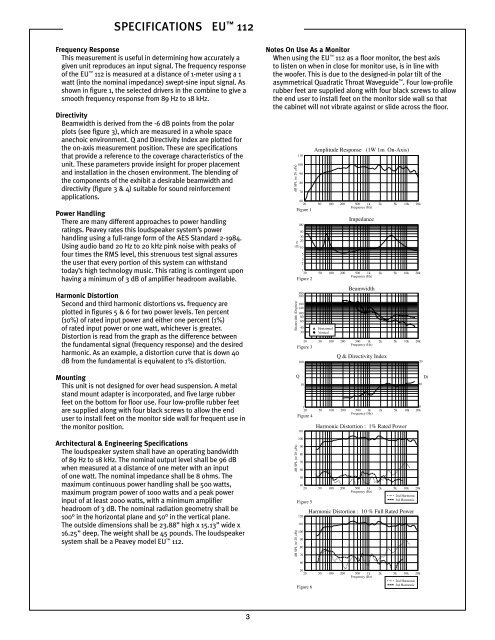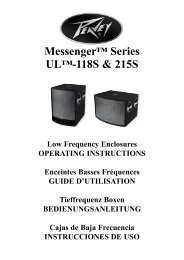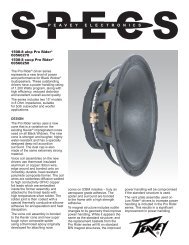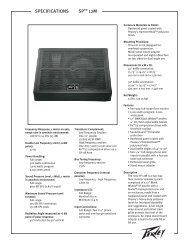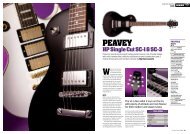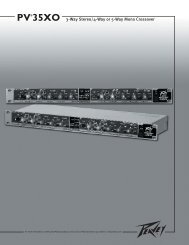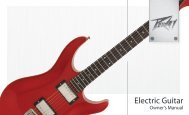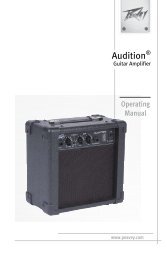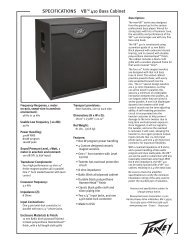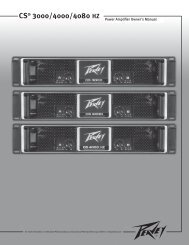EU 112 - Peavey
EU 112 - Peavey
EU 112 - Peavey
You also want an ePaper? Increase the reach of your titles
YUMPU automatically turns print PDFs into web optimized ePapers that Google loves.
SPECIFICATIONS <strong>EU</strong> <strong>112</strong><br />
Frequency Response<br />
This measurement is useful in determining how accurately a<br />
given unit reproduces an input signal. The frequency response<br />
of the <strong>EU</strong> <strong>112</strong> is measured at a distance of 1-meter using a 1<br />
watt (into the nominal impedance) swept-sine input signal. As<br />
shown in figure 1, the selected drivers in the combine to give a<br />
smooth frequency response from 89 Hz to 18 kHz.<br />
Directivity<br />
Beamwidth is derived from the -6 dB points from the polar<br />
plots (see figure 3), which are measured in a whole space<br />
anechoic environment. Q and Directivity Index are plotted for<br />
the on-axis measurement position. These are specifications<br />
that provide a reference to the coverage characteristics of the<br />
unit. These parameters provide insight for proper placement<br />
and installation in the chosen environment. The blending of<br />
the components of the exhibit a desirable beamwidth and<br />
directivity (figure 3 & 4) suitable for sound reinforcement<br />
applications.<br />
Power Handling<br />
There are many different approaches to power handling<br />
ratings. <strong>Peavey</strong> rates this loudspeaker system’s power<br />
handling using a full-range form of the AES Standard 2-1984.<br />
Using audio band 20 Hz to 20 kHz pink noise with peaks of<br />
four times the RMS level, this strenuous test signal assures<br />
the user that every portion of this system can withstand<br />
today’s high technology music. This rating is contingent upon<br />
having a minimum of 3 dB of amplifier headroom available.<br />
Harmonic Distortion<br />
Second and third harmonic distortions vs. frequency are<br />
plotted in figures 5 & 6 for two power levels. Ten percent<br />
(10%) of rated input power and either one percent (1%)<br />
of rated input power or one watt, whichever is greater.<br />
Distortion is read from the graph as the difference between<br />
the fundamental signal (frequency response) and the desired<br />
harmonic. As an example, a distortion curve that is down 40<br />
dB from the fundamental is equivalent to 1% distortion.<br />
Mounting<br />
This unit is not designed for over head suspension. A metal<br />
stand mount adapter is incorporated, and five large rubber<br />
feet on the bottom for floor use. Four low-profile rubber feet<br />
are supplied along with four black screws to allow the end<br />
user to install feet on the monitor side wall for frequent use in<br />
the monitor position.<br />
Architectural & Engineering Specifications<br />
The loudspeaker system shall have an operating bandwidth<br />
of 89 Hz to 18 kHz. The nominal output level shall be 96 dB<br />
when measured at a distance of one meter with an input<br />
of one watt. The nominal impedance shall be 8 ohms. The<br />
maximum continuous power handling shall be 500 watts,<br />
maximum program power of 1000 watts and a peak power<br />
input of at least 2000 watts, with a minimum amplifier<br />
headroom of 3 dB. The nominal radiation geometry shall be<br />
100° in the horizontal plane and 50° in the vertical plane.<br />
The outside dimensions shall be 23.88” high x 15.13” wide x<br />
16.25” deep. The weight shall be 45 pounds. The loudspeaker<br />
system shall be a <strong>Peavey</strong> model <strong>EU</strong> <strong>112</strong>.<br />
Notes On Use As a Monitor<br />
When using the <strong>EU</strong> <strong>112</strong> as a floor monitor, the best axis<br />
to listen on when in close for monitor use, is in line with<br />
the woofer. This is due to the designed-in polar tilt of the<br />
asymmetrical Quadratic Throat Waveguide . Four low-profile<br />
rubber feet are supplied along with four black screws to allow<br />
the end user to install feet on the monitor side wall so that<br />
the cabinet will not vibrate against or slide across the floor.<br />
dB SPL (re 20 Pa)<br />
110<br />
100<br />
90<br />
80<br />
70<br />
Amplitude Response (1W 1m On-Axis)<br />
60<br />
20 50 100 200 500 1k 2k 5k 10k 20k<br />
Figure 1<br />
Frequency (Hz)<br />
100<br />
50<br />
30<br />
20<br />
Z<br />
( ) 10<br />
Beamwidth (Degrees)<br />
dB SPL (re 20 Pa)<br />
dB SPL (re 20 Pa)<br />
5<br />
3<br />
2<br />
Impedance<br />
1<br />
20 50 100 200 500 1k 2k 5k 10k 20k<br />
Figure 2<br />
Frequency (Hz)<br />
360<br />
300<br />
180<br />
140<br />
100<br />
80<br />
60<br />
40<br />
30<br />
Horizontal<br />
Vertical<br />
Beamwidth<br />
20 50 100 200 500 1k 2k 5k 10k 20k<br />
Frequency (Hz)<br />
Figure 3<br />
Q<br />
100<br />
10<br />
Q&Directivity Index<br />
1<br />
0<br />
20 50 100 200 500 1k 2k 5k 10k 20k<br />
Figure 4<br />
Frequency (Hz)<br />
110<br />
100<br />
90<br />
80<br />
70<br />
60<br />
50<br />
Harmonic Distortion : 1% Rated Power<br />
40<br />
20 50 100 200 500 1k 2k 5k 10k 20k<br />
Frequency (Hz)<br />
2nd Harmonic<br />
Figure 5<br />
3rd Harmonic<br />
120<br />
110<br />
100<br />
90<br />
80<br />
70<br />
Harmonic Distortion : 10%Full Rated Power<br />
20<br />
10<br />
Di<br />
60<br />
50<br />
20 50 100 200 500 1k 2k 5k 10k 20k<br />
Frequency (Hz)<br />
2nd Harmonic<br />
Figure 6<br />
3rd Harmonic<br />
3


